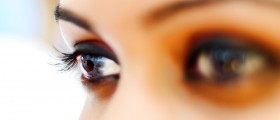
Human eye is a sensory organ that reacts to light allowing the vision. This organ is one of the most complex organs in human body, able to distinguish among 10,000,000 colors. The normal human visual field expands to something like 60° nasally (toward the nose, or inward) in each eye, to 100 ° temporally (away from the nose, or outwards), and approximately 60° above and 75 below the horizontal Meridian. This small but extremely complex organ is made out of many delicate components. This article will try to list them and explain their chief functions
The Cornea
The cornea is a transparent layer of the eye that shields the iris, pupil and anterior chamber. The cornea possesses the ability to refract the light, and it holds somewhere around two thirds of eye’s optical power. The main function of the cornea is to set the focus for the eye.
The Lens
The lens is a transparent structure in the eye that primarily serves to focus the light that enters the eye. Lenses are flexible and can be adjusted to change the focal distance and focus various objects at various distances. This tuning process results in a perfectly sharp image.
The Uvea
The uvea is a middle layer of the eye divided into the iris, ciliary body and choroid. The uvea has an important role to reduce the reflection of the light in the eye and improve the contrast of the retinal image.
The Iris
The iris are circular pigmented structures on the eye. Pigments in the iris determine the color of one’s eyes. Pigments are usually green blue or brown. Iris is made from connective tissues that may affect the contractions of the pupil.
The Pupil
The pupil is a hole in the center of the eye that serves as an entrance for light. Light travels through the pupil to get into the retina. Pupils have their distinctive black color, because the surrounding tissues absorb all of the light that enters into them.
The Retina
The retina is a complex light-sensitive tissue in the inner part of the eye. Retina is actually considered part of the central nervous system because nerve tissues that compose retina send the visual impulses to the brain and create a feeling of a visual world.
The Optic Nerve
The optic nerve, also known as the cranial nerve II, transmits visual impulses from the eye to the brain. The eye's blind spot is a consequence of the absence of photoreceptors in the region of the retina where the optic nerve leaves the eye.
The Sclera
The sclera also known as the white of the eye, is the outer layer of the eye composed of collagen and elastic fiber. The sclera protects the eye from injury and enables it to move.
The Vitreous Humor
The vitreous humor is the colorless gel that fills the space between the lenses and the retina. The main role of the vitreous humor is to keep the retina in place by pressing it against the choroid.

















Your thoughts on this
Loading...